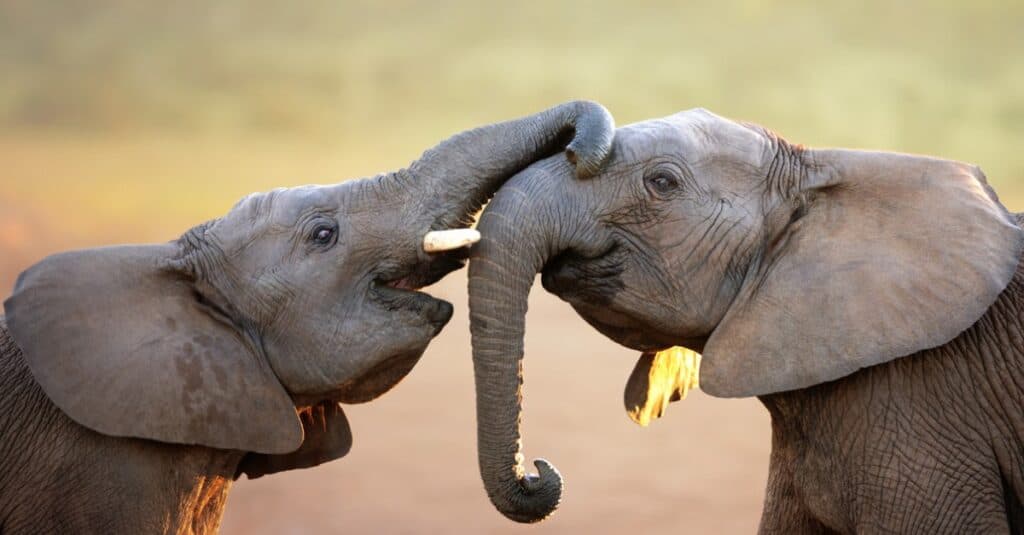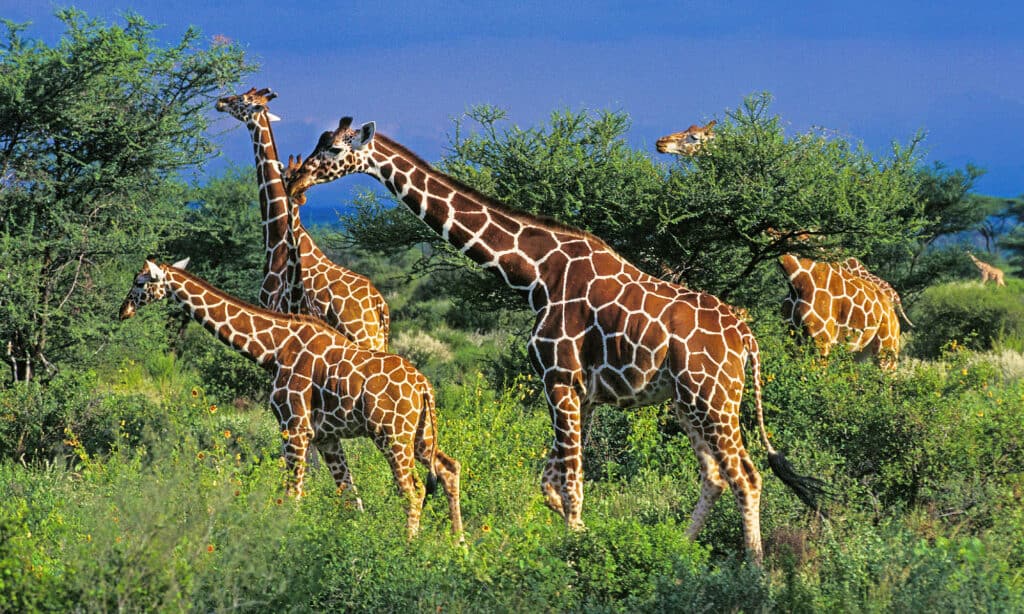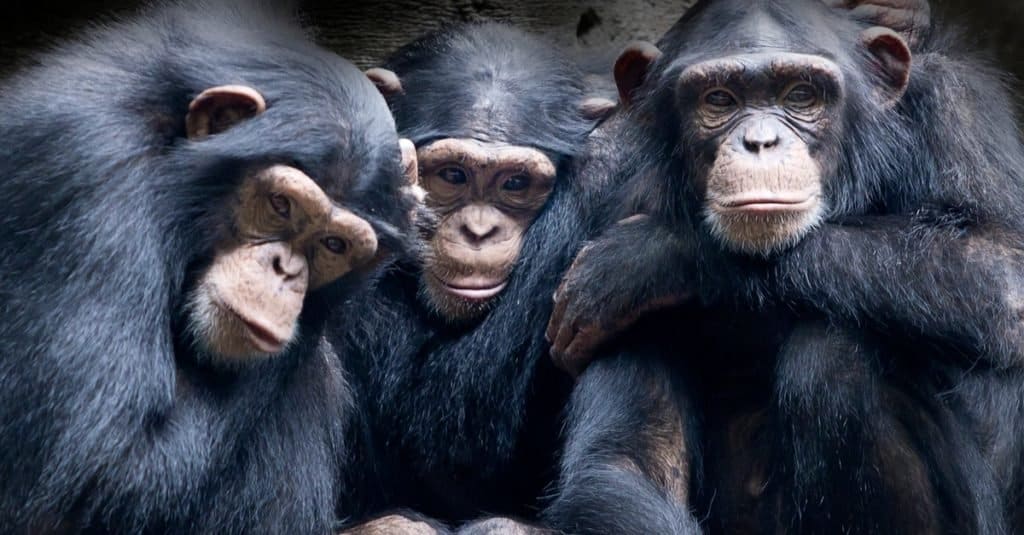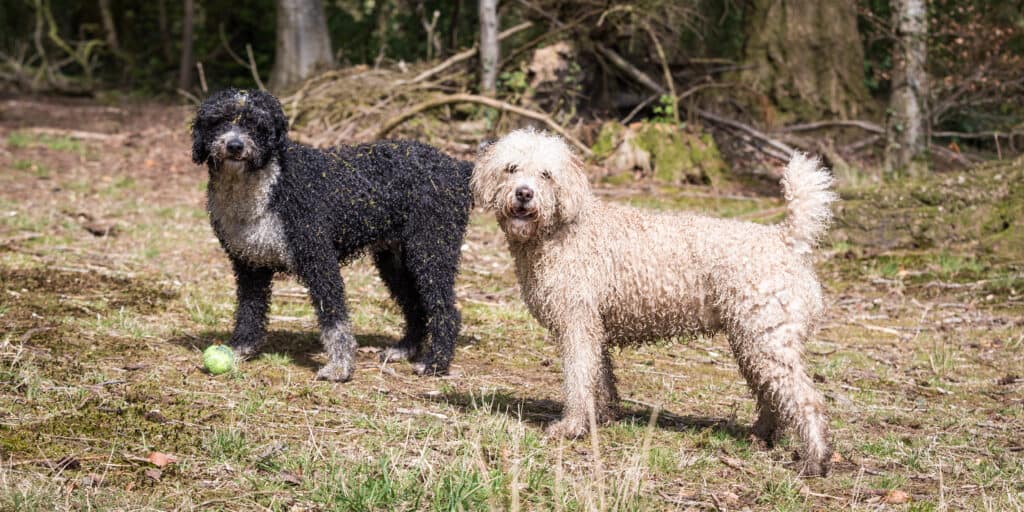Humans aren’t the only species that mourn their loved one’s passing. In fact, there are several animals that grieve and understand death.
Even Darwin thought animals could have all sorts of emotions, like misery and happiness. And these observations have been around for millenniums. For example, Pliny the Elder recorded elephants mourning their dead in 23-79 AD.
However, for centuries, scientists and researchers were too scared to describe this behavior as grieving because they didn’t want to anthropomorphize these species, meaning to attribute human characteristics, intentions, or emotions to animals.
Typical signs of an animal in mourning usually include failing to sleep and eat, becoming socially withdrawn, and changing their traveling routine. While many animals show signs of mourning, here are 5 animals that grieve and understand death.
Elephants Grieve and Understand Death

©iStock.com/johan63
Elephants are the most well-known animal species that mourn their dead. They often visit the carcass of a fallen loved one and keep returning even when the body has decomposed, and all that is left are sun-bleached bones.
Researchers believe this is their way of grieving as they do not show any interest in the carcasses of other large animals like rhinos or buffalo.
In addition, to visiting the deceased elephant, they investigate the remains with their trunks and an acute sense of smell. Their social dynamic also changes around the carcass; for example, interactions with other elephants in the vicinity appear agitated or subdued.
Animals that live in the present don’t understand death; for them, it is just absence. However, intelligent animals with complex social structures and long-term memory, like elephants, realize that death is permanent and thus mourn their loss.
Giraffes Grieve and Understand Death

©slowmotiongli/Shutterstock.com
While they don’t mourn as passionately as elephants, giraffes do understand death and have shown interest in the bodies of their dead companions. For example, in Kenya, one researcher witnessed a mother giraffe staying with her dead calf for several days before finally giving up hope and moving on.
But, while she was mourning, other females joined her, and they all grieved by wrapping their necks around each other, very similar to a hug. They share the need for comfort and touch, just like humans.
In another instance, there have been many sightings of mourning giraffes in the Kruger National Park, South Africa. Tearful tourists report the same behavior; a group of giraffes stands approximately 33 feet from a dead giraffe, staring at the carcass, while the last few vultures eat their fill.
They do nothing to chase away these scavengers; they just stare at it, almost like they are paying their respect. The group will return every day for the next few days, growing less and less interested in the carcass as time goes on. Eventually, after about 4 days, they will move on.
Orcas Grieve and Understand Death

©Nick Grobler/Shutterstock.com
Orcas are another species that mourn their dead. There have been many sightings of killer whale mothers carrying their calves around for a few days after their death.
But, the most heart-breaking observation was when an orca called Tahlequah kept her decomposing calf afloat for 17 days! She just couldn’t seem to part with her baby. Sometimes her calf would sink, and she would dive to retrieve the body and bring it up to the surface.
Finally, after 400 hours, she could no longer keep her calve afloat and let her body sink to the bottom of the Salish Sea.
So, although humans can communicate with animals, there is no doubt that this killer whale was exhibiting intense grief. As with elephants, orcas have complex social lives and advanced brains; they scream intelligence.
Other Cetaceans that Grieve
All cetaceans are highly intelligent and have shown signs of grief and understanding of death. For example, in March 2013, the crew and passengers of a dolphin and whale-watching excursion saw a bottlenose dolphin carrying her dead calf around. They believed that the calf had been dead for several days because of its state of decomposition.
Chimpanzees

©Lili Aini/Shutterstock.com
It’s hard for scientists to determine whether animals grieve because they cannot ask them what they are feeling. Although all the morbid signs point to mourning, there can always be another explanation for their strange behavior.
However, chimpanzees have shown highly indisputable signs that they grieve and understand death. For example, researchers in Zambia have observed wild-born chimpanzees at the Chimfushi Wildlife Orphanage Trust, which were rescued from illegal trade.
They live in massive enclosures in large social groups, and when a 9-year-old male suddenly passed away, the group surrounded his body, appearing to mourn his death.
In another tragic event, a 16-month-old infant died, and its mother carried his lifeless body around for a few days. In addition, she laid its tiny body down in a clearing and continued to visit, gently touching the infant on the face and neck in a show of affection.
Eventually, she carried her deceased baby over to a group of chimpanzees and watched as they investigated the body. However, the following day, researchers could not find the body, and the mother was seen in the presence of the group, who appeared to be comforting her.
In another scenario, famed primate ambassador Jane Goodall observed a mother named Flo pass away before her son, Flint.
Flint was still dependent on his mother, and after her death, he would return to the spot where she died and often started at the nest they shared. In addition, he stopped eating and socializing with the group, which are signs of clinical depression. Sadly, Flint died shortly after his mother due to a compromised immune system and starvation.
Other Primates that Grieve
Pet primates also mourn for their owners, like the langur monkey, who could not let go of its owner after he passed away. This monkey sat by its owner’s open coffin and would not take its hands off the deceased man.
Onlookers saw the monkey caressing the man, not accepting that he won’t wake up. They even claim that the monkey bent down to kiss the man’s face, and in a desperate attempt, the langur shook him, trying to get him to wake up.
Once the ceremony was over, people tried to pull the monkey off the coffin, but he put up a fight; he wasn’t ready to leave his beloved owner.
Dogs

©Daz Stock/Shutterstock.com
Dogs are another animal that grieves over members of their species and human companions. One example of mourning in dogs is withdrawal from social situations. In addition, they could stop eating or drinking, or they could search for their deceased companion.
However, many scientists believe that dogs don’t necessarily understand death; they only realize that their companion is missing. But, there are many dog lovers, researchers, and scientists that do believe that dogs grieve, and these are some signs they have observed:
- Lack of or non-existent appetite
- Withdrawal from other pets and people
- Unusual behavior like aggressiveness or destructiveness
- Subdued or lethargic behavior
- Sleeping more than usual
- Defecating or urinating inside the home
- Vocalizing their anguish or calling out for the deceased pet/human
- Searching for the dead pet/human in places they often frequented
- Becoming incredibly needy and following its owner everywhere
So, don’t be too harsh if your dog shows any of these signs after a family member or pet has passed away. This is normal behavior for a dog in mourning. Instead, reassure your canine companion with lots of praise and love, and if they are behaving destructively, gently discourage and redirect them.
Dogs Grieve Depends on the Relationship
When it comes to mourning, dogs are similar to humans because not all canines will react the same way to grief. People have witnessed dogs grieving for their own species, humans, and other pets. Their behavior will depend on who they are grieving for.
However, some dogs don’t mourn, but that does not mean they are not affected by death, much like humans who process death differently.
Generally, if two dogs share a close bond, they will exhibit behaviors that point to depression after one of them pass.
Depression is the most common sign your dog is mourning, and it can cause a decrease in appetite, problems sleeping, loss of energy, increased anxiety, regular panting, pacing, and destructive behavior.
After losing a close friend, dogs may also lose their spark and seem less attentive, active, and perky. However, dogs may not exhibit any signs of grief if they aren’t close. Surprisingly, dogs might even seem happier after one of them dies because they receive more attention.
But there’s no need for concern if your pup lacks compassion; there is nothing malicious about this behavior; they all process this sad event differently.
Dogs Pick Up on People’s Grief
When owners lose a beloved family member, their dog will pick up on their grief and start to display behavioral changes, much like the owner during this great period of loss.
Dogs can read our:
- Moods
- Odors
- Facial expressions
- Postures
And they feed off of our grief and sadness. For example, several studies have proven stressed owners have stressed dogs. The study concludes that dogs have the same chemical present in humans under severe stress.
So, if your dog exhibits any signs of grief, you must offer reassurance and love. You can try and cheer your pup up with a hug, an extra walk, or let them sleep by your side.
How Long Does Grief Last in Dogs?
The duration of grief depends on the dog and how they process the loss. It also depends on the relationship with the deceased. However, on average, dogs can mourn for 2 to 6 months.
Other factors that determine the length of a dog’s grieving period include:
- The age of the dog
- Health
- The mourning process of the dog’s owners
How You Can Help Your Dog Through their Grief
It’s essential to help your canine companion with their grief. Try to distract them with plenty of exercise and monitor how they eat to ensure they are getting enough food and not starving themselves.
And while you can never replace a loved one, the best way to cheer your pup up would be to get another dog, especially if you work a lot and your dog is alone most of the time. But if this plan is out of the question, arrange puppy play dates, or take your furry friend to a dog park.
Lastly, just be there for your dog, and give them more attention; that way, you are both helping each other overcome the loss of a loved one.
Related Articles
- Do any Animals Commit Suicide?
- Depression in Dogs: Symptoms, Treatment, Causes, and More
- How Smart are Elephants?
The post 5 Animals That Grieve and Understand Death appeared first on AZ Animals.
from Animal News, Facts, Rankings, and More! - AZ Animals https://ift.tt/P3okML1